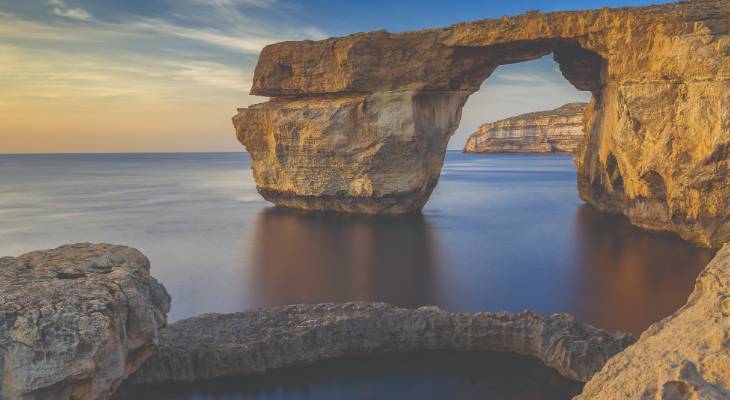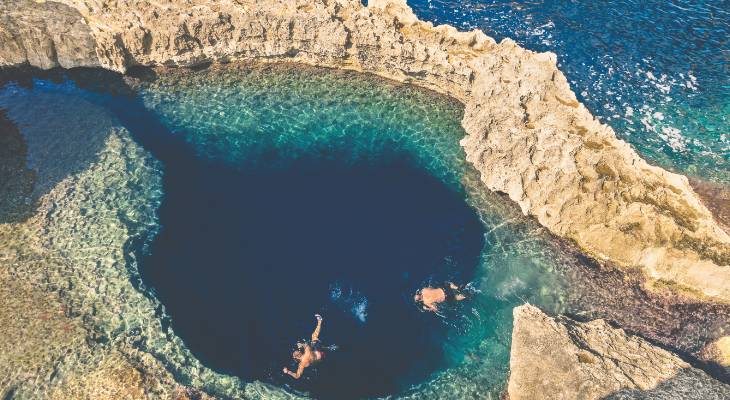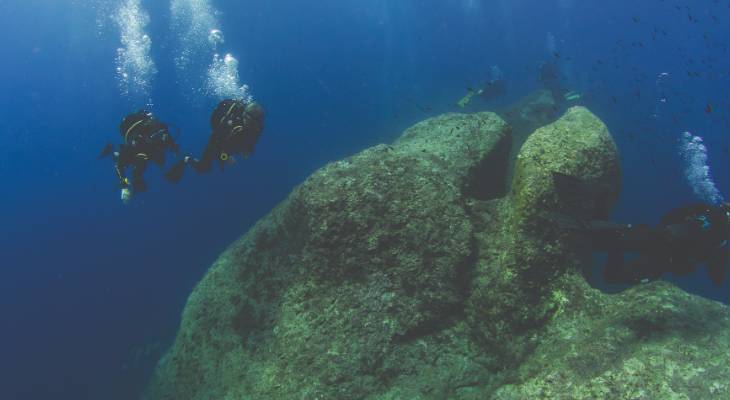Malta has regularly been hailed as one of the top diving destinations in the world. Now, thanks to an unfortunate turn of events, the island’s waters have a new fascinating spot for scuba divers to enjoy.
It’s not every day that a nation mourns a fallen rock formation. Stars who graced our screens and influential figures that left an indelible mark on our lives, sure. Even demolished buildings and defaced works of art we expect to mourn. But the tumbling down of a limestone arch?
It’s meant to be an unfortunate blip caused by the tides of time; an ‘Oh! What a shame’ moment, not an event that inspires a sense of collective loss.
And yet, on the morning of 8 March 2017, as most people were settling into another day of work, news spread like wildfire that Gozo’s beloved Azure Window, which stood prominently over Dwejra Bay, had collapsed during a violent storm that raged through the night.
What followed was a genuine outpouring of sadness on social media and news portals among thousands and thousands of Maltese and Gozitans to whom this iconic arch had been an ever-present national landmark in their lives.
For generations, the Azure Window had been a familiar and iconic backdrop to summer swims and winter picnics in Gozo. Tourists from all over the world flocked to this rugged promontory on the west coast of Gozo to take selfies framed by the arch, long before the word was even a thing. This was also the spot where countless would-be wooers got down on one knee, little felt box in hand, to pop the question to their one true love.

Image credit: viewingmalta.com
The otherworldly Azure Window also brought our islands international fame, having featured in Hollywood classics Clash of the Titans and The Count of Monte Cristo, as well as grimdark TV juggernaut Game of Thrones.
There seemed to be no stopping the alluring spell cast by the Azure Window, despite growing warnings from environmentalists about its looming collapse. It just never seemed like something that would happen in our lifetime. Having stood watch over this pretty pocket of Gozo for centuries, the Azure Window wasn’t so much part of the furniture as it was the showstopper ornament you’d invite guests around to admire.
Then suddenly, in the blink of an eye, it was gone. Or was it?
As the dust and debris of the collapsed Azure Window settled on the seabed, divers exploring the area in subsequent weeks quickly realised they had a new and exciting underwater playground to enjoy. The arch had fallen in such a way as to create a mountain range-like topography under the surface of the sea.

Having opened the St Andrew’s Divers Cove diving centre in Xlendi Bay back in 1989, Mark Busuttil has seen first-hand how this patch of sea in Dwejra has changed since the collapse. “The area off the shore of Dwejra has been a popular diving site in Gozo for many years.
This is largely thanks to the famous Blue Hole. This limestone sinkhole, which goes down to a depth of about 15m, continues to attract scuba divers from all over the world.
It’s a beautiful site to explore with its underwater archways and windows covered in colourful corals, sponges and small marine life. Now the fallen Azure Window, which has left giant rocks strewn across the seabed, is adding to the attraction of the area and we’re seeing more and more divers keen to explore it,” Mark says.
Professional scuba diver and PADI course director Lee Smallwood Cassar agrees. With just under 18,000 dives under his belt, and 20 years of leading scuba tours all around the Maltese archipelago with Sliema-based diving school Diveshack, Lee is deeply familiar with the many sunken sites scattered across Dwejra’s waters.
“It feels almost wrong to say it, but the collapse has made this site a much more interesting dive spot. Before, the Azure Window was a fine enough area to explore. You could dive down from the Blue Hole towards an arch leading out to open water close to the window and swim around the base of the column. But now it’s like swimming across a mountain range under the sea. The highest peak is at 12m and there are also plenty of swim-throughs and tunnels to enjoy. It’s really stunning,” Lee says.

Image credit: Mark Busuttil
In fact, so mountain-like is the topography of the fallen arch that the site has fast become known as the Azure Alps. Recently, an interdisciplinary group of researchers led by Prof Joseph Caruana, has been conducting a study on these underwater remains to better understand the collapse event and map out the present site, which measures approximately 8,000 square metres.
Through exploration dives and photogrammetry efforts, the study showed how erosion at the base of the column caused the pillar to fall and break into two main sections. Large sections from the top of the pillar remained mostly intact, while the bridge of the window fell vertically downwards and fragmented. The team was able to build a 3D-model to serve as a guide for divers looking to visit the site and further explore the Azure Window’s remains.
“There are multiple reasons why this area fascinates people and continues to gain international recognition as one of the best dive sites in the Mediterranean,” Mark explains. “First of all, it’s an excellent spot for all levels of divers. It can be enjoyed by people who have just finished their open water course, while providing an exciting and challenging trip for more experienced divers. Also, there’s so much to explore. You can reach four or five different dive sites from the Blue Hole, including the Azure Alps. Some people come to Gozo to spend a whole week diving around the caves, shallows, and swim-throughs off Dwejra’s coast. It’s a fascinating site to explore.”
Lee also points out the uniqueness of the Azure Alps and Blue Hole area: “though Malta and Gozo don’t have abundant marine life, our underwater topography is unlike anything else around the world. That’s why many experienced divers, who have travelled to some of the world’s most exotic diving locations, continue to return to our islands. Also, recently we have been seeing marine life around Dwejra’s water begin to thrive again, with small tuna, grouper, and amberjacks returning to the area. Deeper down you’ll also come across bream, bass, and parrot fish among other sea life.”
With summer around the corner, and Malta looking forward to a busier holiday season following the lull of the pandemic, the Azure Alps are already generating lots of interest from scuba divers eager to explore this spectacular underwater terrain for themselves.
Will you be visiting the Azure Window this summer?
This feature was first carried in the May 2022 edition of the Guide Me magazine, the sister brand to GuideMeMalta.com.